
Algebra 2 by Richard Wright
Are you not my student and
has this helped you?
Objectives:
SDA NAD Content Standards (2018): AII.5.3, AII.5.4, AII.6.5, AII.7.1, AII.7.2, AII.7.3

Experiments and studies that investigate relationships such as time a person spends reading the Bible and how well the person treats others sometimes give a linear relationship. In this proposed study, the more time spent reading the Bible may cause the person to treat others better.
A scatter plot is a graph of many data points. They help identify trends in the data by using correlation coefficient, r. The correlation coefficient is a number between –1 and 1 that measure how well the data fits a line. Positive correlation coefficients are for positive slopes, and negative coefficients for negative slopes. The better the points fit a line, the closer the correlation coefficient will be to 1 or –1.
Positive correlation means the slope of the scatter plot tends to be positive. The correlation coefficient will be positive.
Negative correlation means the slope of the scatter plot tends to be negative with a negative correlation coefficient.
No correlation means there is no obvious pattern from the scatter plot. The correlation coefficient will be near zero.



For each scatter plot, a) tell whether the data have a positive correlation, a negative correlation, or approximately no correlation, and b) tell whether the correlation coefficient is closest to –1, –0.5, 0, 0.5, or 1.



Solution
Graph I: The points are nearly in a straight line with a positive slope so positive correlation with r ≈ 1.
Graph II: The points resemble a line with negative slope, but the points are not perfectly in a line so negative correlation with r ≈ −0.5.
Graph III: The points do not appear to make a line, so no correlation with r ≈ 0.
The best-fitting line is the line that most closely approximates the data in a scatter plot.
To find the best-fitting line,
A new plant food was introduced to a young tree to test its effect on the height of the tree. The table shows the height of the tree, in feet, x months since the measurements began. a) Write a linear function, H(x), where x is the number of months since the start of the experiment. b) Use your function to approximate the height of the tree at 14 months.
| x | 0 | 2 | 4 | 8 | 12 |
|---|---|---|---|---|---|
| H(x) | 12.5 | 13.5 | 14.5 | 16.5 | 18.5 |
Solution
Draw a scatter plot.

Draw the best fitting line.

Pick two points on the line and find the equation of the line. Pick (8, 16.5) and (12, 18.5) because the line appears to go right through both of those points. Find the slope.
$$ m = \frac{18.5-16.5}{12-8} = \frac{2}{4} = \frac{1}{2} $$
Fill in m and a point (x, y) into y = mx + b. Use (8, 16.5).
$$ 16.5 = \frac{1}{2} \left(8\right) + b $$
16.5 = 4 + b
b = 12.5
Fill in m and b into y = mx + b.
$$ y = \frac{1}{2} x + 12.5 $$
The question asks for function H(x) so change the y to H(x).
$$ H\left(x\right) = \frac{1}{2} x + 12.5 $$
Fill in 14 for x and find H(x).
$$ H\left(14\right) = \frac{1}{2} \left(14\right) + 12.5 = 19.5 $$
The height will be 19.5 ft.
While estimating a best-fitting line works reasonably well, there are better statistical techniques for minimizing the distances from line to the data points. One such technique is called least squares regression and can be computed by many graphing calculators, spreadsheet software, statistical software, and many web-based calculators. Least squares regression is one means to determine the best-fitting for the data. Least squares regression is often called linear regression.
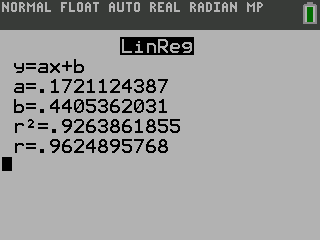
The calculator will display the equation. To see the graph of the points and line, press GRAPH.
Note: Older TI graphing calculators do not have the screen in steps 6 and 7. After selecting the LinReg(ax+b), the screen just shows "LinReg(ax+b)". Press ENTER again to see the result. To see the graph, enter the equation into the Y= screen and press GRAPH.
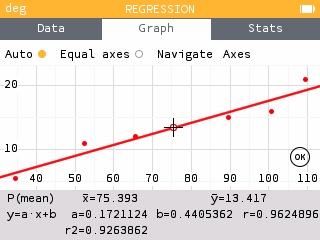
Find the least squares regression line using the cricket-chirp data in Table 1.
On a TI-84 graphing calculator
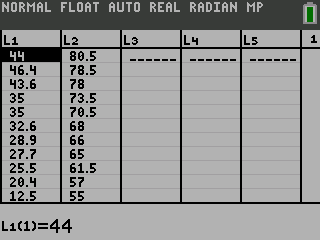
Note: To see the graph, enter Y1 for Store RegEQ: before pressing Calculate. Y1 is found in VARS → Y-VARS ↓ Function… ↓ Y1
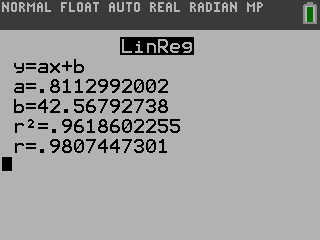
T(c) = 0.811c + 42.57
The graph of the scatter plot with the least squares regression line is shown in figure 11.
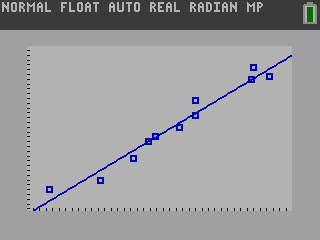
On a NumWorks graphing calculator
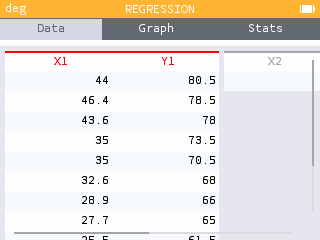
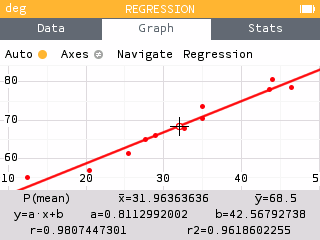
T(c) = 0.811c + 42.57
For each scatter plot, a) tell whether the data have a positive correlation, a negative correlation, or approximately no correlation, and b) tell whether the correlation coefficient is closest to −1, −0.5, 0, 0.5, or 1.




a) Draw a scatter plot using the data in the table, then b) tell whether the data have a positive correlation, a negative correlation, or approximately no correlation, and c) tell whether the correlation coefficient is closest to −1, −0.5, 0, 0.5, or 1.
| x | 0 | 1 | 2 | 3 | 4 | 5 |
|---|---|---|---|---|---|---|
| y | 5 | 4.2 | 4.3 | 3.5 | 3.1 | 2.3 |
| x | 0.5 | 1 | 1.5 | 2 | 2.5 | 3 | 3.5 | 4 |
|---|---|---|---|---|---|---|---|---|
| y | 2 | 2.2 | 2.4 | 2.6 | 2.8 | 3 | 3.2 | 3.4 |
a) Draw a scatter plot using the data in the table, then b) write the equation of the best fitting line.
| x | 0 | 0.5 | 1 | 1.5 | 2 | 2.5 | 3 | 3.5 | 4 |
|---|---|---|---|---|---|---|---|---|---|
| y | 1 | 1.6 | 2 | 2.4 | 3 | 3.6 | 4 | 4.4 | 5 |
| x | 0 | 0.5 | 1 | 1.5 | 2 | 2.5 | 3 | 3.5 | 4 |
|---|---|---|---|---|---|---|---|---|---|
| y | 5 | 4.4 | 3.8 | 3.2 | 2.6 | 2 | 1.4 | 0.8 | 0.2 |
| x | 0 | 0.5 | 1 | 1.5 | 2 | 2.5 | 3 | 3.5 | 4 |
|---|---|---|---|---|---|---|---|---|---|
| y | 2.1 | 2.3 | 2.5 | 2.7 | 2.9 | 3.1 | 3.3 | 3.5 | 3.7 |
| x | 0 | 0.5 | 1 | 1.5 | 2 | 2.5 | 3 | 3.5 | 4 |
|---|---|---|---|---|---|---|---|---|---|
| y | 5.8 | 5 | 4.2 | 3 | 1.8 | 1 | 0.2 | −1 | −2 |
Problem Solving
| t | 0.05 | 0.10 | 0.15 | 0.20 | 0.25 | 0.30 | 0.35 |
|---|---|---|---|---|---|---|---|
| x | 0.05 | 0.10 | 0.16 | 0.22 | 0.27 | 0.33 | 0.37 |

Piping Plovers are small birds that live on sandy beaches in the United States. In 1985 they were put on the endangered species list. The following table gives the number of breeding pairs found on the Atlantic Coast. a) Draw a scatter plot of the data and b) write the equation of the best fitting line. Use P for Plovers and t for years since 1985.
| t | 1 | 3 | 5 | 7 | 9 | 11 | 13 | 15 | 17 | 19 | 21 | 23 | 25 |
|---|---|---|---|---|---|---|---|---|---|---|---|---|---|
| P | 790 | 886 | 982 | 1013 | 1162 | 1364 | 1379 | 1437 | 1690 | 1658 | 1749 | 1849 | 1782 |
Mixed Review
 ; negative correlation; r ≈ −0.5
; negative correlation; r ≈ −0.5 ; positive correlation; r ≈ 1
; positive correlation; r ≈ 1








